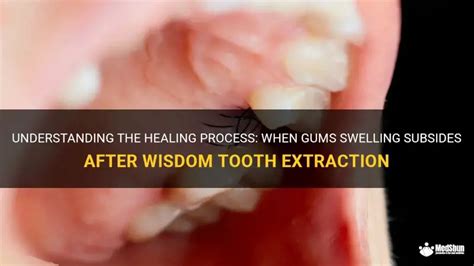Swollen Gums After Extraction

Swollen gums after a tooth extraction are a common phenomenon, experienced by many individuals who have undergone this dental procedure. The swelling is usually a result of the body’s natural response to the trauma caused by the extraction, and it can be quite uncomfortable. Understanding the reasons behind this swelling, its symptoms, and how to manage it can help alleviate concerns and promote a smooth recovery.
Why Do Gums Swell After a Tooth Extraction?
When a tooth is extracted, the gum tissue surrounding it can become inflamed due to the surgical procedure. This inflammation is part of the body’s healing process, as it signifies the beginning of the repair and rebuilding of the affected area. The swelling can be attributed to several factors, including:
- Bleeding and Clotting: After the tooth is removed, a blood clot forms in the socket. The process of bleeding and clotting can lead to swelling in the surrounding gum tissue.
- Infection: Although not common, if the extraction site becomes infected, it can cause significant swelling and pain.
- Trauma: The act of extraction itself can cause trauma to the gum tissue, especially if the tooth was impacted or if there were complications during the procedure.
Symptoms of Swollen Gums After Tooth Extraction
The symptoms associated with swollen gums after a tooth extraction can vary from person to person but typically include:
- Pain: The swelling can be painful, and the level of discomfort can range from mild to severe.
- Discomfort: Eating, drinking, and even talking can become uncomfortable due to the swelling.
- Limited Mouth Opening: In severe cases, the swelling can be so significant that it limits the ability to open the mouth fully.
- Facial Swelling: Sometimes, the swelling can extend beyond the gums to the face, particularly if the extracted tooth was in the upper jaw.
Managing Swollen Gums After Tooth Extraction
Fortunately, swollen gums after a tooth extraction are a temporary condition that can be managed with proper care and attention. Here are some ways to alleviate the discomfort and promote healing:
Immediate Post-Extraction Care
- Apply Ice: Cold compresses or ice packs can help reduce swelling. It’s recommended to apply them for 15 minutes at a time, with a 30-minute break in between.
- Rest: Avoid strenuous activities for the first 24 hours to prevent dislodging the blood clot.
- Soft Foods: Stick to a diet of soft foods for the first few days to avoid irritating the extraction site.
- Oral Hygiene: Gentle brushing and rinsing with salt water can help keep the area clean without causing further irritation.
Medication and Pain Management
- Pain Relievers: Over-the-counter pain medications, such as ibuprofen or acetaminophen, can help manage pain and reduce inflammation.
- Antibiotics: If there’s a risk of infection, your dentist may prescribe antibiotics.
Follow-Up Care
- Dental Check-Ups: It’s crucial to follow up with your dentist as recommended to ensure the extraction site is healing properly.
- Professional Cleaning: Once the site has healed sufficiently, a professional dental cleaning can help remove any plaque or bacteria that may have accumulated.
How long does gum swelling typically last after a tooth extraction?
+The duration of gum swelling after a tooth extraction can vary, but it usually subsides within 3 to 7 days. However, everyone's healing process is different, and in some cases, it may take longer.
Is it normal for the swelling to spread to the face or neck?
+While some facial swelling can be normal, especially if the extraction was in the upper jaw, significant or spreading swelling could be a sign of infection or other complications. If you're concerned, it's best to consult your dentist.
Can I use warm compresses to help with the swelling?
+Warm compresses are generally recommended after the initial 24 hours. They can help loosen up any blood clots and promote healing. However, it's essential to avoid using heat during the first day as it can dislodge the clot and delay healing.
Conclusion
Swollen gums after a tooth extraction are a common and generally temporary condition. By understanding the causes, recognizing the symptoms, and following proper care and management strategies, individuals can minimize discomfort and promote a healthy recovery. If concerns or severe symptoms persist, it’s always best to consult with a dental professional for personalized advice and treatment.
